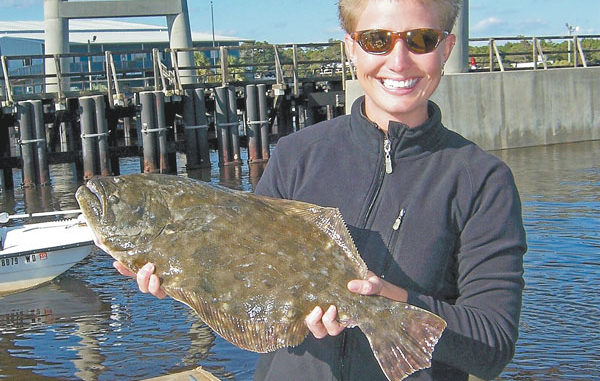
October brings great inshore action for flounder and redfish to Brunswick County waters.
The nice thing about fishing North Carolina’s coastline this month is that anglers can catch just about any inshore species. Trips are often short, and fishermen can set up shop on the shoreline and often match the results of those in boats.
Inshore fishing was slow to decent during this past summer, a horrendously hot and humid one in the Tarheel State. Hot weather sends a lot of favored species — flounder in particular — into deeper water around artificial reefs and hardbottoms. Red drum, probably the second most-popular species, scatter out and can be caught only sporadically.
But with October comes change, and the change in water temperature drives fish and fishermen.
“The water temperatures start to cool down, and fish, especially baitfish, start moving toward the ocean, basically through the inlets,” said guide Keith Logan of Feedin’ Frenzy Charters in Holden Beach, who pointed to 78 degrees as one magic number when fish start to move to places where they can feed up for the winter on the baitfish moving into the channels.
“When the temperature drops inside to 68 degrees, they start going back out the inlets,” said Logan (843-907-0064). “And you can catch ’em then, too.”
West of the Cape Fear River, Brunswick County’s coastline is divided by three inlets— Lockwood Folly, Shallotte, Tubbs and Mad Inlet — that finger mullet and menhaden, the prime baitfish for flounder and red drum, use to head for shallower, then deeper water.
“October is a good time to fish for flounder and reds all up and down this area,” said Logan, 40, an Ocean Isle native. “Most of the flounder will be between 18 and 20 inches, but you’ll get a lot of larger flounder, too. People catch flounder weighing up to 10 pounds occasionally, and there are plenty of 4-, 5-, 6- and 8-pounders caught.”
A real plus for fishermen targeting reds or flounder is that both species can be caught in the same areas using the same lures and baits.
“It’s not that you catch them in the same spots, but you can fish for them in the same spots,” Logan said. “That’s saying you can anchor up just a few yards from the shoreline, I’d say 20 or 25 yards, and fish from the shallow-water side of the boat back to the boat and expect to catch reds. They’ll often be cruising very near the marsh grass banks. Then you can cast your lures or baits into deeper water, say eight to 10 feet, and expect to catch flounder.
“The really ideal spot to find is a dock that stretches out into water that’s deep at the ends and pitch a finger mullet or artificial back up under the dock and work it out. You also can fish toward the channel and either let a bait sit on the bottom or work it slowly back to you.”
One of the best spots for reds and flounder is just a few hundred yards down the left side of the marsh where Bluewater Point Marina sits at the west end of Oak Island.
A road once led to Lockwood Folly Inlet at the western end of Oak Island and made a complete circle. However, a hurricane (probably Hazel in 1954) roared across the island and swept clean every house on the west end and buried half of the circular drive under tons of sand. That section of West Beach remained undeveloped until the early 1990s, when a real-estate boom triggered a flurry of house-building. Although the road hasn’t been rejoined, homes with boat docks stretching to the water along the marsh on the back side of Oak Island now dot the shoreline, and those docks and the water between them provide excellent flounder and redfish habitat.
“Not every dock and area in-between will hold reds and flounder,” Logan said. “I don’t know why; that’s just the way it is. I’ve fished up here enough to know the good places.”
Another advantage of fishing such areas is the availability of live bait, primarily finger mullet. Schools will be visible along the shoreline, and it’s fairly easy to drop a 6- or 8-foot spread cast net over them and get enough live baits to last an entire day.
Logan uses Shimano and Ugly Stick rods and matches them with Shimano reels.
“I like to use 6-foot-6 or 8-foot rods, most of them with Shimano Stradic 2500 and 4000 spinning reels, but with the 8-foot rod, I use a Shimano Calais reel,” said Logan, who uses 20-pound High Seas braid for its strength and castability.
“You want something that won’t break if a hooked-up red gets in the reeds when the tide’s high, and it’s strong and won’t break in other instances,” he said.
For leaders, he uses a 3-foot section of fluorocarbon because of its strength and invisibility in the water.
“This tackle will work with Carolina rigs or lures,” said Logan, who likes No. 3 or No. 4 O’Shaugnessy hooks when he’s going for flounder and reds, but his live-bait terminal tackle also includes a 3/8ths- to half-ounce barrel weight above the leader, which is tied to a standard black saltwater barrel swivel.
“The best way to hook a finger mullet is vertically, from underneath its jaw and out between his two nostrils,” Logan said. “That way he can swim naturally.”
When using artificial lures, he prefers 3- and 4-inch Gulp! soft-plastic shrimp — durable, scented lures that have become a favorite of many saltwater anglers. He fishes them on Barefoot Tackle’s Gitzem jigheads in 1/16th, eighth and quarter-ounce sizes.
“When I take a group of novices out, I like to let them throw the artificial lures more than live bait,” Logan said. “You don’t get too many people who have the patience or understand how a flounder eats a minnow. It takes a while for a flounder to de-scale a minnow, turn it around it his mouth and swallow it head first.
“People feel that first ‘tick’ on their line and want to set the hook, but all they’re doing is pulling the minnow out of the flounder’s mouth. But when a flounder takes an artificial lure, he’ll usually slam it. The same applies to red drum; they’ll smack an artificial every time.”
When reds eat live baits, they’ll also often hit them hard, but more often, an angler notices his bait first being harassed by pinfish. Then a red will take the minnow in its mouth and swim slowly away, causing a rod tip to dip with a corresponding steady pull on the line. It’s best to count to three, then set the hook.
Two new Berkley lures also will catch reds and flounder — 5- to 6-inch jerkshad and the Havoc Grass Pig.
Jerkshad are slender, soft-plastic lures with split tails and a groove that can hide a hook inserted into their bodies. They’re best fished with leadhead jigs of varying weights, depending upon current strength and water depth.
Jot Owens of Wilmington’s JottaDown Charters prefers jerkshad for deeper flounder fishing around reefs and wrecks and also inshore.
“My deeper-water patterns for flounder are 5- to 6-inch jerkshad in pearl/white, chartreuse/pepper, neon or new penny with a 3/8ths- to half-ounce jighead,” Owens said. “A 6-inch jerkshad on the rising tide at the ICW seems to catch bigger flounder. There’s not a lot of them, but when you hook one, it’s usually a keeper.”
Owens has just started using the Grass Pig, a longer, more-slender version of an old freshwater favorite, the Sassy Shad. It has a ribbed body, paddletail and is scented identically to Gulp! baits.
“It’s a soft-plastic lure and was created to be a (freshwater) bait, but it catches flounder as well as redfish,” Owens said. “You can rig it weedless and throw it into flooded marsh grass where reds go at high tide, and it’ll come through easily.”
His favorite colors are pearl/white with silver flakes, swamp gas (brown with black flakes) and California (black with red flakes).
Logan also targets flounder by drifting incoming or outgoing tides at Lockwood Folly Inlet with strip baits or Gulp! plastics on the bottom.
“One of the good things about October, too, is the bigger reds seem to come into the inlets and go up the rivers because there’s so much moving bait,” he said. “There’s one creek off the Lockwood Folly River where you can go in there and throw a Gulp! and drag it across the bottom and it’ll get hit every time.”
One thing’s for sure, anglers who choose October to visit the Brunswick coast will have a lot of gamefish to chase and won’t see the like again until spring.

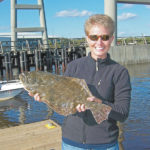
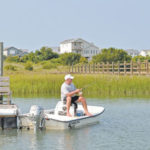
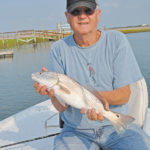
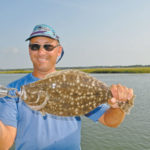
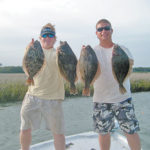
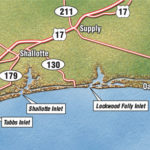




Be the first to comment